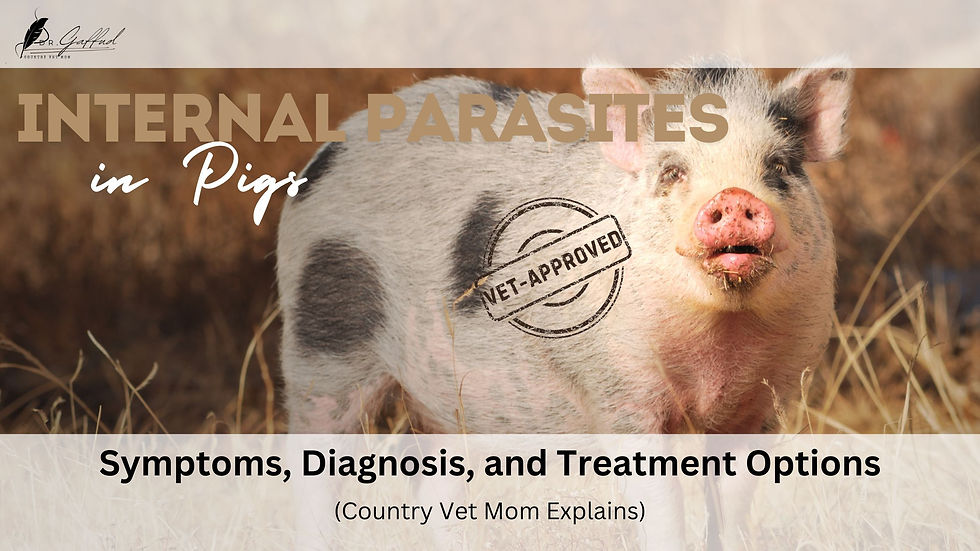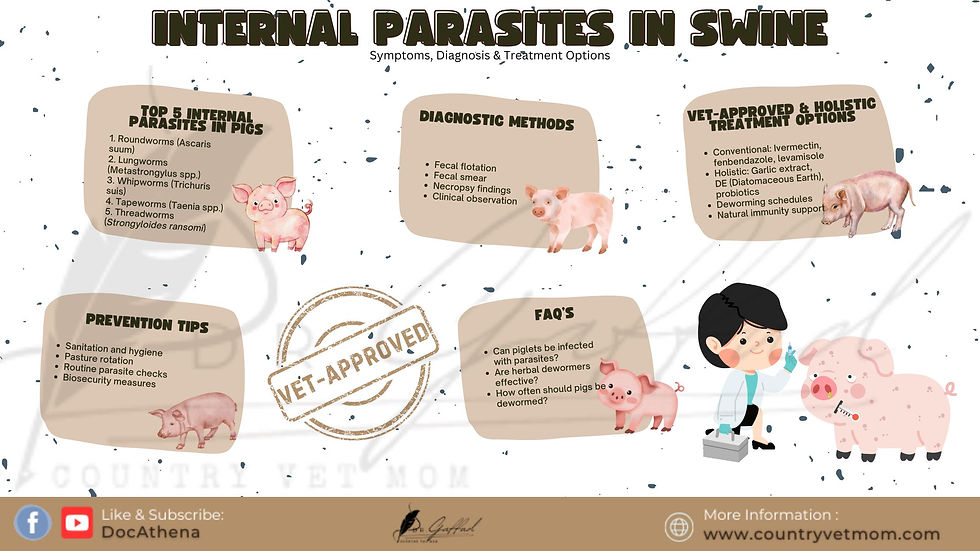Top 5 Internal Parasites in Swine: Symptoms, Diagnosis, and Treatment Options
- Dr. Gaffud

- 16 hours ago
- 4 min read

Swine internal parasites are a persistent threat to pig health, farm productivity, and economic returns. These hidden invaders disrupt digestion, suppress immunity, and hinder weight gain, resulting in significant setbacks in both backyard and commercial pig farms. Knowing how to identify, diagnose, and treat internal parasites in swine is critical for disease prevention and herd health management.
This comprehensive guide discusses the top five internal parasites in swine, offering in-depth insights into their symptoms, diagnosis, and treatment. It also explores holistic care options and practical biosecurity measures, making it a must-read for veterinarians, farmers, and swine producers alike.
Table of Contents:
Roundworms in Swine: A Common Internal Parasite with Serious Effects
Lungworms in Swine: Respiratory Threats from Internal Parasites
Tapeworms in Swine: Zoonotic Internal Parasites with Public Health Implications
Threadworms in Swine: Early-Life Internal Parasites with Severe Consequences
Holistic Care for Swine Internal Parasites: Prevention Beyond Medication
Frequently Asked Questions about Internal Parasites in Swine
Roundworms in Swine: A Common Internal Parasite with Serious Effects
Roundworms (Ascaris suum) are among the most common and damaging internal parasites in pigs, particularly young ones.
Symptoms:
Poor weight gain: Inadequate increase in body mass over time.
Coughing and respiratory distress: Symptoms resulting from larval migration affecting the respiratory system.
Pot-bellied appearance: Distended abdomen indicative of underlying health issues.
Digestive upset: Disruption in normal digestive processes, often leading to reduced feed efficiency.
Diagnosis: Veterinarians typically diagnose roundworm infections via fecal flotation to detect eggs. Necropsy may reveal visible adult worms in the small intestine.
Treatment: Roundworms are treatable using broad-spectrum anthelmintics, such as Ivermectin, Pyrantel, or Fenbendazole. Regular deworming and manure management are essential to control the spread.
Lungworms in Swine: Respiratory Threats from Internal Parasites
Lungworms (Metastrongylus spp.) primarily affect pigs reared outdoors, especially where earthworms (intermediate hosts) are present.
Symptoms:
Chronic coughing: A persistent cough lasting more than eight weeks, often associated with respiratory issues.
Labored breathing: Difficulty in breathing that requires additional effort, indicating potential respiratory distress.
Nasal discharge: The presence of mucus or fluid coming from the nose, often indicating infection or allergies.
Slower growth rates: Reduced speed in growth and development, commonly seen in response to health problems.
Diagnosis: Fecal analysis using flotation or Baermann techniques can reveal lungworm larvae. Post-mortem lung examination may confirm infestation.
Treatment: Effective treatments include Ivermectin and Levamisole. Pasture rotation and preventing pigs from rooting in areas where earthworms are abundant help reduce the risk.
Whipworms in Swine: A Hidden Culprit Behind Diarrhea
Whipworms (Trichuris suis) are resilient parasites that thrive in environments contaminated with feces.
Symptoms:
Watery or bloody diarrhea: A condition characterized by the presence of loose, watery stools that sometimes contain blood.
Weight loss and dehydration: Loss of body weight accompanied by a significant decrease in body fluids, leading to dryness and potential health issues.
Rough coat and weakness: Dull, unkempt fur accompanied by a noticeable reduction in physical strength and energy.
Diagnosis: Fecal flotation is used to detect whipworm eggs. However, intermittent egg shedding can make detection challenging.
Treatment: Fenbendazole and Oxantel are effective treatments. Deep-cleaning pig pens and removing contaminated bedding are essential components of control.

Tapeworms in Swine: Zoonotic Internal Parasites with Public Health Implications
While less common, tapeworms (Taenia solium) pose a dual threat: they impair pig health and can also infect humans via undercooked pork.
Symptoms:
Visible tapeworm segments in feces: The presence of segments indicates a tapeworm infestation in the gastrointestinal tract.
Decreased appetite: Reduction in the desire to eat, often associated with gastrointestinal disturbances.
Growth retardation: Slower than normal physical development or increase in size, typically due to underlying health issues.
Diagnosis: Tapeworm segments (proglottids) are detectable in feces. Confirmatory diagnosis requires laboratory egg identification.
Treatment: Praziquantel is the primary treatment. Preventing pigs from accessing human feces is vital to interrupt the tapeworm life cycle.
Threadworms in Swine: Early-Life Internal Parasites with Severe Consequences
Threadworms (Strongyloides ransomi) are particularly dangerous to neonatal piglets.
Symptoms:
Severe diarrhea: Excessive and frequent watery bowel movements.
Dehydration: The loss of body fluids, which leads to potential health issues.
Skin irritation and scouring: Inflammation or damage to the skin, often resulting from exposure to irritants.
Mortality in severe infections: Increased risk of death associated with serious infections.
Diagnosis: Direct fecal smear or flotation reveals threadworm larvae. Early detection is key due to rapid progression in piglets.
Treatment: Threadworms respond well to Ivermectin or Doramectin. Sows should be treated pre-farrowing to prevent transmission to piglets via milk.
Holistic Care for Swine Internal Parasites: Prevention Beyond Medication
A growing number of swine producers are incorporating holistic parasite control strategies into their conventional management practices. While these methods must not replace veterinary care, they help support long-term parasite resistance and gut health.
Natural Approaches for Swine Internal Parasites
Diatomaceous earth: May reduce internal parasite load when mixed with feed
Pumpkin seeds: Contain cucurbitacin, a compound thought to expel parasites
Herbal blends: Wormwood, garlic, neem, and oregano oil may assist in mild cases
Fermented feeds and probiotics: Promote gut health and immune function
Always consult a veterinarian before using holistic remedies, especially for pregnant sows or piglets.

Frequently Asked Questions about Internal Parasites in Swine
How do pigs get internal parasites?
Pigs acquire internal parasites through contaminated soil, feces, or intermediate hosts, such as earthworms and beetles. Unsanitary living conditions increase the risk.
How often should pigs be dewormed?
Typically, pigs should be dewormed every 4 to 6 months. However, the frequency of deworming varies depending on age, environment, and the level of parasite pressure.
Are swine internal parasites contagious to humans?
Some parasites, like Taenia solium, infect humans. Proper hygiene, cooking meat thoroughly, and preventing pigs from accessing human waste are crucial preventive measures.
Can I prevent parasites without medication?
While good hygiene, nutrition, and pasture management reduce the risk, they are not substitutes for veterinary-guided deworming programs.
Are natural treatments enough for swine parasite control?
Natural remedies may support mild infestations but are not effective for severe cases. Always prioritize veterinary advice and approved anthelmintics.
Conclusion: Managing Internal Parasites in Swine for Healthier Herds
Internal parasites in swine are a manageable threat when approached with knowledge, consistency, and veterinary guidance. From roundworms and lungworms to tapeworms and threadworms, each parasite presents unique challenges. Accurate diagnosis, effective treatment, regular deworming, sanitation, and preventive care are the pillars of parasite control.
By combining evidence-based veterinary medicine with holistic support and biosecurity practices, farmers and veterinarians maintain optimal swine health and ensure sustainable herd productivity.



Comments